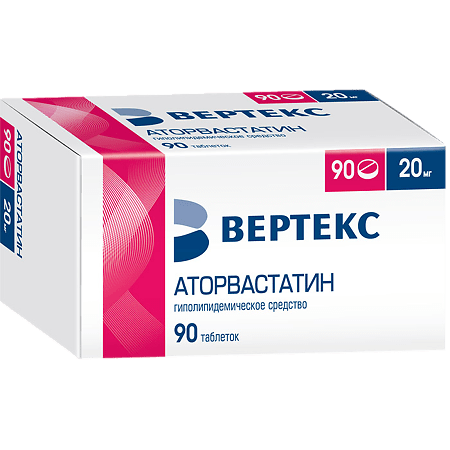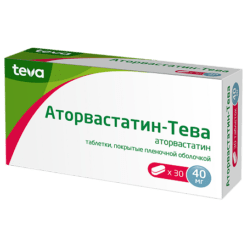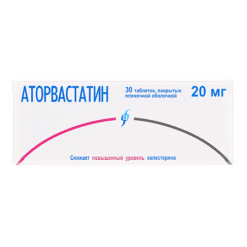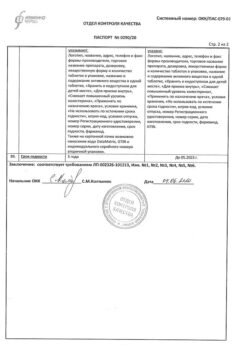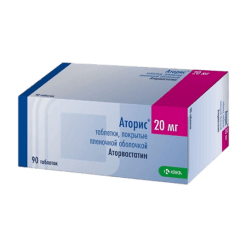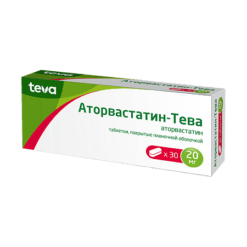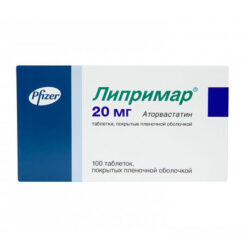No products in the cart.
Atorvastatin-Vertex, 20 mg 90 pcs
€1.00
Out of stock
(E-mail when Stock is available)
Description
Hypolipidemic drug from the group of statins. Selective competitive inhibitor of HMG-CoA reductase – an enzyme that converts 3-hydroxy-3-methylglutarylcoenzyme A into mevalonic acid, which is a precursor of sterols, including cholesterol.
Triglycerides and cholesterol in the liver are incorporated into LDL, enter the blood plasma and are transported to peripheral tissues. LDL are formed from LDLNP during interaction with LDL receptors.
Indications
Indications
Atorvastatin is used:
. – in combination with diet to reduce elevated total cholesterol, cholesterol/LDL, apolipoprotein B, and triglycerides and to increase HDL cholesterol concentration in patients with primary hypercholesterolemia, heterozygous familial and nonfamilial hypercholesterolemia, and combined (mixed) hyperlipidemia (Fredrickson types IIa and IIb);
– in combination with diet for the treatment of patients with increased triglycerides content in serum (Fredrickson type IV) and patients with dysbetalipoproteinemia (Fredrickson type III), in which diet therapy does not provide an adequate effect;
– for lowering concentrations of total cholesterol and cholesterol/LDL in patients with homozygous familial hypercholesterolemia when diet therapy and other non-pharmacological methods of treatment are not effective enough.
Active ingredient
Active ingredient
Composition
Composition
How to take, the dosage
How to take, the dosage
Before Atorvastatin is prescribed, a standard hypolipidemic diet should be recommended for the patient, which the patient should continue to follow during the entire period of therapy.
The drug is taken orally, at any time of the day with food or regardless of the time of meals.
The dose is adjusted for baseline cholesterol/LDL levels, the goal of therapy, and individual effect. The initial dose is on average 10 mg once daily. The dose varies from 10 to 80 mg once daily.
At the beginning of treatment and/or during dose escalation of Atorvastatin, plasma lipid levels should be monitored every 2-4 weeks and the dose should be adjusted accordingly.
In primary hypercholesterolemia and mixed hyperlipidemia as well as in hyperlipidemia types III and IV according to Fredrickson in most cases a dosage of 10 mg once daily is sufficient. Significant therapeutic effect is usually observed after 2 weeks; the maximum therapeutic effect is usually observed after 4 weeks. With long-term treatment this effect is maintained.
In homozygous familial hypercholesterolemia, the drug is given in a dose of 80 mg (4 tablets of 20 mg) once daily.
Application in patients with renal impairment and renal disease has no effect on plasma levels of atorvastatin or on the degree of reduction of cholesterol/LDL when using the drug, therefore no change in the drug dose is required.
In case of hepatic impairment, the dose should be reduced.
There were no differences in safety, efficacy or achievement of hypolipidemic therapy goals when using the drug in elderly patients compared to the general population.
Interaction
Interaction
Special Instructions
Special Instructions
Before starting therapy with Atorvastatin, a standard hypocholesterolemic diet should be prescribed to the patient, which should be followed during the entire period of treatment. The use of HMG-CoA reductase inhibitors to reduce blood lipid concentrations may lead to changes in biochemical parameters reflecting liver function.
Liver function should be monitored before initiation of therapy, at 6 weeks, 12 weeks after initiation of Atorvastatin and after each dose increase, as well as periodically, e.g., every 6 months. Elevation of hepatic enzymes activity in serum may be observed during therapy with Atorvastatin.
Patients with elevated enzyme activity should be monitored until the values return to normal. If ALT or ACT values are more than 3 times higher than GGN, it is recommended to reduce the dose of Atorvastatin or discontinue treatment.
Atorvastatin should be used with caution in patients who abuse alcohol and/or have liver disease. Active liver disease or persistent increase in aminotransferase activity of unclear genesis are contraindications to Atorvastatin administration.
Treatment with Atorvastatin may cause myopathy. The diagnosis of myopathy (pain and weakness in muscles combined with an increase in CPK activity of more than 10 times that of CHF) should be discussed in patients with widespread myalgia, muscle soreness or weakness and/or a marked increase in CPK activity.
Patients should be cautioned to inform their physician immediately of unexplained muscle pain or weakness if accompanied by malaise or fever. Therapy with Atorvastatin should be discontinued if there is a marked increase in CPK activity or if there is confirmed or suspected myopathy.
The risk of myopathy during treatment with other drugs of this class was increased with concomitant use of cyclosporine, fibrates, erythromycin, nicotinic acid or antifungal agents from azole group. Many of these drugs inhibit CYP3A4-mediated metabolism and/or drug transport.
Atorvastatin is biotransformed by CYP3A4. When prescribing Atorvastatin in combination with fibrates, erythromycin, immunosuppressive agents, antifungal agents from azole group or nicotinic acid in hypolipidemic doses, the expected benefits and risks of treatment should be carefully weighed and patients should be regularly observed to detect muscle pain or weakness, especially during the first months of treatment and during periods of increasing dose of any drug.
In such situations, periodic determination of CPK activity may be recommended, although such monitoring does not prevent the development of severe myopathy.
There have been cases of rhabdomyolysis with acute renal failure due to myoglobinuria when using Atorvastatin, as well as other drugs of this class. Therapy with Atorvastatin should be temporarily discontinued or completely discontinued if there are signs of possible myopathy or if there are risk factors of renal failure with rhabdomyolysis (for example, severe acute infection, arterial hypotension, serious surgery, trauma, severe metabolic, endocrine and electrolyte disorders and uncontrolled convulsions).
Before initiating therapy with Atorvastatin, an attempt should be made to achieve control of hypercholesterolemia through adequate dietary therapy, increasing physical activity, reducing body weight in obese patients and treating other conditions.
Patients should be warned to seek immediate medical attention if they experience unexplained muscle pain or weakness, especially if accompanied by malaise or fever.
Influence on driving and operating ability
There have been no reports of adverse effects of Atorvastatin on driving and operating ability.
Side effects
Side effects
Nervous system disorders: more commonly 2% – insomnia, dizziness; less commonly 2% – headache, asthenia, malaise, somnolence, nightmares, paresthesias, peripheral neuropathy, amnesia, emotional lability, ataxia, facial nerve palsy, hyperkinesias, migraine, depression, hypoesthesia, unconsciousness.
Sensory organs: less frequently 2% – amblyopia, tinnitus, dry conjunctiva, accommodation disorder, retinal hemorrhage, deafness, glaucoma, parosmia, loss of taste sensation, perversion of taste.
Cardiovascular system: frequently 2%, chest pain; less frequently 2%, palpitations, vasodilatory symptoms, orthostatic hypotension, increased BP, phlebitis, arrhythmias, angina pectoris.
Hematopoietic system disorders: less frequently 2% – anemia, lymphoadenopathy, thrombocytopenia.
In the respiratory system:more commonly 2% – bronchitis, rhinitis; less frequently 2% – pneumonia, dyspnea, exacerbation of bronchial asthma, nasal bleeding.
Digestive system disorders: more often 2% – nausea; less frequently 2% – heartburn, constipation or diarrhea, flatulence, gastralgia, abdominal pain, decreased or increased appetite, dry mouth, belching, dysphagia, vomiting, stomatitis, esophagitis, glossitis, erosive and ulcerative lesions of the oral mucosa, gastroenteritis, hepatitis, biliary colic, cheilitis, duodenal ulcer, pancreatitis, cholestatic jaundice, liver dysfunction, rectal bleeding, melena, bleeding gums, tenesmus.
Muscular system disorders: frequently 2% – arthritis; less frequently 2% – leg muscle cramps, bursitis, tenosynovitis, myositis, myopathy, arthralgia, myalgia, rhabdomyolysis, torticollis, muscle hypertonicity, joint contractures.
Uinary system disorders:more frequently 2% – peripheral edema; less frequently 2% – dysuria (including pollakiuria, nycturia, urinary incontinence or urinary retention, urgent urge to urinate, nephritis, hematuria, nephrourolithiasis.
Gender and mammary gland disorders: more often 2% – urogenital infections; less often 2% – vaginal bleeding, metrorrhagia, epididymitis, decreased libido, impotence, ejaculation disorders, gynecomastia, mastodynia.
Skin and subcutaneous tissue: frequently 2% – alopecia, xeroderma, increased sweating, eczema, seborrhea, ecchymoses, petechiae.
Allergic reactions: rarely 2% – skin itching, skin rash, contact dermatitis” rarely – urticaria, angioedema, facial edema, photosensitization, anaphylaxis, erythema multiforme exudative (including Stevens-Johnson syndrome), toxic epidermal necrolysis (Lyell syndrome).
Laboratory findings: rarely 2% – hyperglycemia, hypoglycemia, increased serum CPK, albuminuria.
Others: rarely 2% – weight gain, aggravation of gout.
Overdose
Overdose
Pregnancy use
Pregnancy use
Similarities
Similarities
Additional information
| Shelf life | 2 years. |
|---|---|
| Conditions of storage | The drug should be kept out of reach of children, dry and protected from light at a temperature not exceeding 25 ° C. |
| Manufacturer | Vertex, Russia |
| Medication form | pills |
| Brand | Vertex |
Other forms…
Related products
Buy Atorvastatin-Vertex, 20 mg 90 pcs with delivery to USA, UK, Europe and over 120 other countries.

